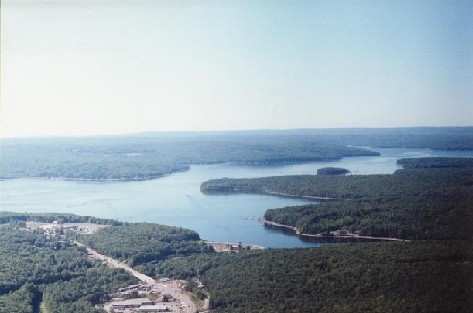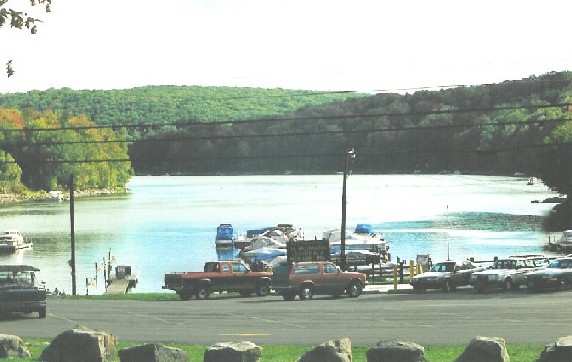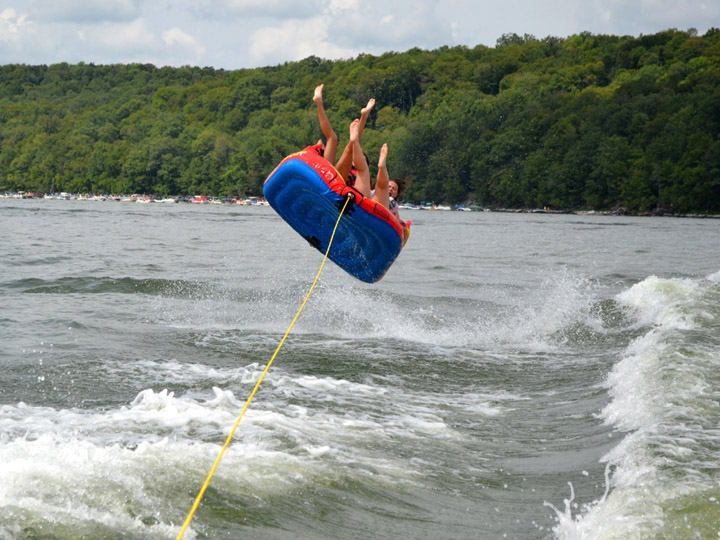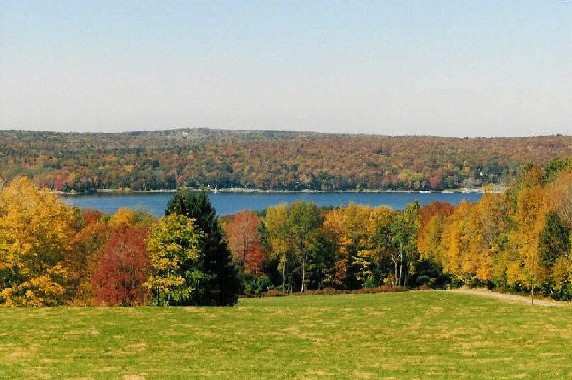
Lake Wallenpaupack

Lake Wallenpaupack, who's name means "the stream of swift and slow water" in local Indian language, is situated along the border of Wayne and Pike counties in northeastern Pa.. The lake was created in 1926 by the Pennsylvania Power and Light company as a hydro-electric generating facility. This generating facility is still in use today, although it is only used in a supplemental capacity now. The lake was formed by the damming of the Wallenpaupack Creek, which resulted in an approximately 13 mile long lake, with a 1 mile width at it's widest point near the dam end and, thanks to numerous coves, about 52 miles of shoreline. Click here for a map of the area with areas of interest marked. For a live look at the lake, click here or here.
The most obvious benefit to be had from the creation of such a large lake (At one time it was the largest man-made lake in Pa, today it is #3.), is the enormous recreational opportunities which were made possible. The lake supports a variety of boating related activities including cruising, water skiing, sailing, fishing, and even scuba diving. For the fisherman, there are several species of Bass, Pike, Catfish, Walleye, Trout, Pickerel and others. For the cruiser and skier, there is a large expanse of water, just begging to be traversed, which can provide hours of enjoyable fun. Finally, for the diver, there are the mysteries of the underwater unknown. There have been persistent rumors, spread over the years, that there are remains of a house still on the bottom, left over from an old homestead which had been flooded when the lake was originally created. But these rumors have been recently dispelled by PP&L lake historians who put the matter to rest when they stated unequivocally, that all buildings were completely razed or relocated before the lake bed was flooded. But there are some leftover man-made rock walls and other distinct features, like the remains of bridge abutments and building foundations from the town of Wilsonville, a few lost anchors, an outboard motor or two, and perhaps even a sunken boat (or car), which can provide the prospective diver with some interesting features to explore.
The size and number of boats, seen on the lake, varies on any given day. You can find anything from a 12' aluminum fishing boat to a 30' cabin cruiser, although PP&L rules prohibit overnighting on boats. In the winter, the lake usually freezes over fairly solidly and people have been known to venture out on it with everything from iceboats to snowmobiles. Many also partake in ice fishing and skating. Another local legend involves a car or truck which supposedly had driven out on the frozen lake, had subsequently found itself on some thin ice, and had broken through and sunk. The jury is still out on whether the story's true or not, but I've heard it told many times over the years as part of the local lore. In the past, as part of the local festivities, a contest was held where a replica of PP&L's mascot, Reddy Kilowatt, was placed on a metal structure on the ice in the cove adjacent to the Tafton Dike. People would then make guesses as to which day Reddy would break through the thinning ice in the spring. The closest guesser won a prize.
Besides the large open expanse of water and numerous coves, the lake is also home to 4 islands, which dot the water at various points. The largest island is named Epply, and it is situated more toward the dam end of the lake just before Shuman Point. There are picnic tables, pedestal charcoal grills, and even a "Job Johnny" type toilet there for day picnickers to use and enjoy. In years past, the fourth of July fireworks show was launched from Epply as well. The other 3 islands are closer to the creek end of the lake and are progressively smaller. Their names are Kipp, Cairns, and Burns. Kipp Island is almost as large as Epply and sports a fairly sandy beach in a semi-protected cove on one side, which makes for easy beaching of boats and lessens the risk of gouging a boat's gelcoat on the sharp edged rocks which typically surround the rest of the islands. The calm cove (known locally as "Party Cove") in the no-wake zone behind Cairns island, has become a popular rafting spot for boaters. The popularity of the cove, and the sheer amount of boats found there on any given weekend in the summer, has created a rift between the sometimes rowdy partying boaters and the waterfront residents along that stretch of the water, who complain about the noise made by the daytime partiers. Burns Island is the smallest of the 4 islands, and when the lake water level is highest in the spring, it's barely larger than 2 tennis courts. PP&L allows day picnicking on these islands, but prohibits overnight camping (bummer!).
Since we're on the subject of camping, PP&L operates 4 public campgrounds for family camping. These campgrounds are spaced fairly evenly around the lake. The Wilsonville campground is the largest and is located in Tafton, between the dike and the dam. The campsites in this campground are a little too densely packed for my tastes, and the lake access is virtually unprotected in the widest part of the lake, so there is almost always some chop during the day. The Caffrey Campground is on the north side of the lake off of RT 590. It's a smaller campground and most of the sites are out in the open with little tree cover. The lake access is also pretty much unprotected, although being in a cove offers a slight bit more protection than at Wilsonville. The third campground is Ironwood point, located on the south side of the lake off of RT 507, directly across from Burns Island. Ironwood Point has many sites in scenic wooded surroundings and even has some lake front walk-up, tent-only sites, which offer a terrific view of the lake. The only downside to this campground is the unprotected lake access. Last, but certainly not least, is Ledgedale. This campground is at the very beginning of the lake, at the mouth of the Wallenpaupack Creek. This campground offers scenic wooded campsites and protected lake access in a no-wake zone, which usually results in much calmer water even during the most crowded of weekends.
Here is a picture of the Ledgedale recreation area:

Homes line most of the southern side of lake, and a good part of the northern side as well. Most of the lake front homes also have docks. PP&L regulations prohibit the sinking of pilings, and the construction of "permanent" structures, so the docks are all of the removable floating variety. Also, the lake level varies during the year as PP&L discharges water to generate power or to help regulate the water level of the Lackawaxen River, which the lake drains into. Normally, the lake is at the highest level (1187') in the late spring followed by a gradual lowering during the summer, with the lowest level (1179') occurring in the late fall. This changing lake level, which can vary the water depth up to 8', mandates that docks be able to "move" with the lake level so as to remain in good water. The average mean depth of the lake itself varies from between 20 and 60 feet, with the deepest areas near the dam itself. There are very few shallow areas. Those few areas are clearly marked with "danger" buoys, and are usually only a problem in the late summer and fall when the lake's level is on the low side. You can also travel a mile or so up the Wallenpaupack Creek past the Ledgedale recreation area. But it's a no-wake zone and there is little to see other than more homes and, if you're lucky, a quick glimpse of a deer or two. You will eventually run out of navigable water at some point, so keep a watchful eye on the depth finder.
Getting your boat into the lake is not usually a problem. There is only one "public" (read:free) boat launch ramp, which is located in Mangan cove, adjacent to the dam, off of Pa. route 590. It is maintained by the Pa. Fish and Boat Commission, and offers a good sized parking lot along with toilet facilities and places to load and unload your boat. There are also launch ramps located at the 4 PP&L campsites which surround the lake. These are open to the public, but you are charged a fee to use them. Most of the full service lake side marinas also offer ramp access for a fee. There are also private ramps, which are for the exclusive use of the members of the private communities or clubs which maintain them.
The growing popularity of the area over the years, has made weekend boat traffic on the lake somewhat busy and crowded. A 45 MPH speed limit has been enacted during summer weekends, to help manage the crowd and hopefully reduce the potential for mishaps. With this much on-water traffic, it can get a bit rough, especially if the wind adds to the chop generated by boat wakes. If riding comfort is a priority, I would not recommend a boat smaller than 20' that weighs at least 3000 lbs. Smaller and lighter boats will pound on the heavy chop, making the experience less than fun, especially for those of us with back problems.
Skiing and tubing during the weekend can also be a bit dicey if a calm section of water is what you crave. One of my favorite spots to ski and tube is on the dam end of the lake, in a place known as "Walt's Cove". It is somewhat sheltered from the main lake traffic (and wakes) by Shuman point on one side and Paupack point on the other. Another good spot is the bottom of Martin's cove, at the north center of the lake, just beyond the Cove Haven resort. The deep cove will give you some protection from the chop on the main part of the lake, but a lot of people know this, so the area can become crowded with a bunch of people all trying to ski, to the point where a traffic controller might be needed. It's also become a favorite spot for boaters to anchor, so the cove tends to fill up on the weekends. But even the small amount of shelter those places provide may not be enough on especially busy or windy weekends. If you like to ski or tube, your best bet is to go during the week, when the boat traffic is much less, which is what I have been doing for the last several years.

I first fell in love with this area in the mid 1970's, when I used to stay at "Walt's Landing", a quaint summer trailer/cottage resort at the bottom of Walt's Cove. Since then, I have been making the trek to the lake at least once a year and staying at one of the PP&L campgrounds. My favorite campground is Ledgedale, at the total opposite end of the lake from Walt's Cove. This campground is in a less traveled area, the marina is in a no-wake zone, and the facilities are more scenic. The parking lot adjacent to the launch ramp can become a zoo on the weekends though, which is another reason why I prefer a stay during the week.
In the fall, the entire area is treated to a display of brilliant colors, which is a beauty which must be seen first hand to fully appreciate.


In conclusion:
Pros: It's a relatively large lake, which can appease the need to cruise. You can run for a couple of hours before you might start to get bored. It's also very scenic, with some places still undeveloped (or hidden well). There's also something very tranquil and soothing about this place, a feeling which I can't exactly put my finger on, but it's one of the main reasons why I keep coming back. The water's fairly clean as well, which is a plus when you spend a lot of time in it.
Cons: I have a hard time finding any serious cons. If I had to come up with some, I would have to say that the distance from my home makes it impractical for a day trip. Also the ever increasing weekend traffic and, IMHO, the relentless development of the area, will be the eventual ruination of what is now a very special place. Like in the Joni Mitchell song where they paved paradise to put up a parking lot, I sure hope they don't turn this place into a concrete jungle. God help us all if they ever legalize gambling here.